Implicit Geomodelling of the Merensky and UG2 Reefs of the Bushveld Complex from Open-Source Data: Implications for the Complex’s Structural History
Abstract
:1. Introduction
1.1. Geological Context
1.2. Geomodelling Theory
- (1)
- Modelled surfaces may be pinned locally with hard data, such as drillhole intersections and reef outcrops;
- (2)
- Surfaces may be guided by non-contacting data, such as density contrasts from unconstrained geophysical data inversions [37];
- (3)
- (4)
- Extrapolation away from known or hard data, into areas where there is effectively no data, may be achieved intelligently and logically using trends. Such inputs remove, for example, instances where Merensky and UG2 reefs cross one another; and
- (5)
- Directional interpretation bias, inherent in section-based explicit modelling, is minimized.
1.3. Conceptual Models: Connectivity between Eastern and Western Limbs
2. Materials and Methods
- (1)
- Establishment of a volume of interest;
- (2)
- Incorporation of data and its quality control;
- (3)
- Subdivision into structural domains;
- (4)
- Subdivision of structural domains into geological units; and
- (5)
- Review and modification of resultant geological units and volumes.
2.1. Model Construction
2.2. Structural Network Incorporation
2.3. Surface Construction Technique
- (1)
- Construction of reference surfaces for both Merensky and UG2 reefs from mapping data, drillhole-derived downhole reef intersections and surface reef contours;
- (2)
- Construction of structural trends, incorporating trends and surfaces produced in unconstrained geophysical data inversions (see Basson, 2019 [11] for a description of these); and
- (3)
- Construction of final surfaces.
2.4. Reference Surface Construction
2.5. Construction of Structural Trends
2.6. Construction of Final Surfaces
3. Results
4. Discussion
5. Conclusions
Author Contributions
Funding
Acknowledgments
Conflicts of Interest
References
- Cawthorn, R.G.; Webb, S.J. Connectivity between the Western and Eastern Limbs of the Bushveld Complex. Tectonophysics 2001, 330, 195–209. [Google Scholar] [CrossRef]
- Cawthorn, R.G. The Residual or Roof Zone of the Bushveld Complex, South Africa. J. Petrol. 2013, 54, 1875–1900. [Google Scholar] [CrossRef] [Green Version]
- Lee, C.A. Post-deposition structures in the Bushveld Complex mafic sequence. J. Geol. Soc. 1981, 138, 327–341. [Google Scholar] [CrossRef]
- Webb, S.J.; Cawthorn, R.G.; Nguuri, T.; James, D. Gravity modeling Bushveld complex connectivity supported by Southern African Seismic Experiment results. S. Afr. J. Geol. 2004, 107, 207–218. [Google Scholar] [CrossRef]
- Letts, S.; Torsvik, T.H.; Webb, S.; Ashwal, L.D. Palaeomagnetism of the 2054 Ma Bushveld Complex (South Africa): Implications for emplacement and cooling. Geophys. J. Int. 2009, 179, 850–872. [Google Scholar] [CrossRef] [Green Version]
- Vermaak, C.F.; Hendriks, L.P. A review of the mineralogy of the Merensky Reef, with specific reference to new data on the precious metal mineralogy. Econ. Geol. 1976, 71, 1244. [Google Scholar] [CrossRef]
- Du Plessis, A.; Kleywegt, R.J. A dipping sheet model for the mafic lobes of the Bushveld Complex (South Africa). S. Afr. J. Geol. 1987, 90, 1–6. [Google Scholar]
- Uken, R.; Watkeys, M.K. Diapirism initiated by the Bushveld Complex, South Africa. Geology 1997, 25, 723–726. [Google Scholar] [CrossRef]
- Cawthorn, R.G.; Walraven, F. Emplacement and crystallization time for the Bushveld Complex. J. Petrol. 1998, 39, 1669–1687. [Google Scholar] [CrossRef]
- Bamisaiye, O.A.; Eriksson, P.G.; Van Rooy, J.L.; Brynard, H.M.; Foya, S.; Billay, A.Y.; Nxumalo, V. Subsurface mapping of Rustenburg Layered Suite (RLS), Bushveld Complex, South Africa: Inferred structural features using borehole data and spatial analysis. J. Afr. Earth Sci. 2017, 132, 139–167. [Google Scholar] [CrossRef]
- Basson, I.J. Cumulative deformation and original geometry of the Bushveld Complex. Tectonophysics 2019, 750, 177–202. [Google Scholar] [CrossRef]
- Hunter, D.R. The Regional Geologic Setting of the Bushveld Complex (An Adjunct to the Provisional Tectonic Map of the Bushveld Complex); Economic Geology Research Unit, University of the Witwatersrand: Johannesburg, South Africa, 1975; pp. 1–18. [Google Scholar]
- Uken, R. The Geology and Structure of the Bushveld Complex Metamorphic Aureole in the Olifants River Area; University of Natal: Durban, South Africa, 1998. [Google Scholar]
- Eales, H.V.; Cawthorn, R.G. The Bushveld Complex. Dev. Petrol. 1996, 15, 181–229. [Google Scholar]
- Cawthorn, R.G.; Eales, H.V.; Walraven, F.; Uken, R.; Watkeys, M.K. The bushveld complex. In The Geology of South Africa; Johnson, M.R., Anhaeusser, C.R., Thomas, R.J., Eds.; Geological Society of South Africa: Pretoria, South Africa, 2006; pp. 261–281. [Google Scholar]
- Lenhardt, N.; Eriksson, P.G. Volcanism of the Palaeoproterozoic Bushveld Large Igneous Province: The Rooiberg Group, Kaapvaal Craton, South Africa. Precambrian Res. 2012, 214–215, 82–94. [Google Scholar] [CrossRef] [Green Version]
- Du Plessis, C.P.; Walraven, F. The tectonic setting of the Bushveld Complex in Southern Africa, Part 1. Structural deformation and distribution. Tectonophysics 1990, 179, 305–319. [Google Scholar] [CrossRef]
- Hulbert, L.J.; von Gruenewald, G. Nickel Copper, and Platinum Mineralization in the Lower Zone of the Bushveld Complex, South of Potgietersrus. Geology 1982, 77, 1296–1306. [Google Scholar] [CrossRef]
- Buick, I.S.; Maas, R.; Gibson, R. Precise U–Pb titanite age constraints on the emplacement of the Bushveld Complex, South Africa. J. Geol. Soc. 2001, 158, 3–6. [Google Scholar] [CrossRef]
- Kruger, F.J. Filling the Bushveld Complex magma chamber: Lateral expansion, roof and floor interaction, magmatic unconformities, and the formation of giant chromitite, PGE and Ti-V-magnetitite deposits. Miner. Depos. 2005, 40, 451–472. [Google Scholar] [CrossRef]
- Clarke, B.; Uken, R.; Reinhardt, J. Structural and compositional constraints on the emplacement of the Bushveld Complex, South Africa. Lithos 2009, 111, 21–36. [Google Scholar] [CrossRef]
- Boorman, S.; Boudreau, A.; Kruger, F.J. The Lower Zone-Critical Zone transition of the Bushveld Complex: A quantitative textural study. J. Petrol. 2004, 45, 1209–1235. [Google Scholar] [CrossRef]
- Eales, H.V.; Botha, W.J.; Hattingh, P.J.; de Klerk, W.J.; Maier, W.D.; Odgers, A.T.R. The mafic rocks of the Bushveld Complex: A review of emplacement and crystallization history, and mineralization, in the light of recent data. J. Afr. Earth Sci. 1993, 16, 121–142. [Google Scholar] [CrossRef]
- Hunter, D.R.; Hamilton, P.I. The Bushveld complex. In Evolution of the Earth’s Crust; Tarling, D.H., Ed.; Academic Press: London, UK, 1978; pp. 103–107. [Google Scholar]
- Naldrett, T.; Kinnaird, J.; Wilson, A.; Chunnett, G. Concentration of PGE in the Earth’s Crust with Special Reference to the Bushveld Complex. Earth Sci. Front. 2008, 15, 264–297. [Google Scholar] [CrossRef]
- Eales, H.V.; Costin, G. Crustally-contaminated komatiite: Primary source of the chromitites and marginal, Lower, and Critical zone magmas in a staging chamber beneath the Bushveld Complex. Econ. Geol. 2012, 107, 645–665. [Google Scholar] [CrossRef]
- Seabrook, C.L.; Cawthorn, R.G.; Kruger, F.J. The Merensky reef, Bushveld Complex: Mixing of minerals not mixing of magmas. Econ. Geol. 2005, 100, 1191–1206. [Google Scholar] [CrossRef]
- Cameron, E.N. Chromite in the central sector of the Eastern Bushveld Complex, South Africa. Am. Mineral. 1977, 62, 1082–1096. [Google Scholar]
- Cawthorn, R.G. The platinum and palladium resources of the Bushveld Complex. S. Afr. J. Sci. 1999, 95, 481–489. [Google Scholar]
- Voordouw, R.; Gutzmer, J.; Beukes, N. Zoning of platinum group mineral assemblages in the UG2 chromitite determined through in situ SEM-EDS-based image analysis. Miner. Depos. 2010, 45, 147–159. [Google Scholar] [CrossRef]
- Cawthorn, R.G.; Spies, L. Plagioclase content of cyclic units in the Bushveld Complex, South Africa. Contrib. Mineral. Petrol. 2003, 145, 47–60. [Google Scholar] [CrossRef]
- Schouwstra, R.P.; Kinloch, E.D.; Lee, C.A. A Short Geological Review of the Bushveld Complex. Platin. Met. Rev. 2000, 44, 33–39. [Google Scholar]
- Scoates, J.S.; Friedman, R.M. Precise Age of The Platiniferous Merensky Reef, Bushveld Complex, South Africa, by the U-Pb Zircon Chemical Abrasion Id-Tims Technique. Econ. Geol. 2008, 103, 465–471. [Google Scholar] [CrossRef]
- Vollgger, S.; Cruden, A.; Ailleres, L.; Cowan, J. Regional dome evolution and its control on ore-grade distribution: Insights from 3D implicit modelling of the Navachab gold deposit, Namibia. Ore Geol. Rev. 2015, 69, 268–284. [Google Scholar] [CrossRef]
- Bloomenthal, J.; Wyvill, B. Introduction to Implicit Surfaces; Morgan Kaufmann Publishers Inc.: San Francisco, CA, USA, 1997. [Google Scholar]
- Caumon, G.; Gray, G.; Antoine, C.; Titeux, M. Three-Dimensional Implicit Stratigraphic Model Building from Remote Sensing Data on Tetrahedral Meshes: Theory and Application to a Regional Model of La Popa Basin, NE Mexico. IEEE Trans. Geosci. Remote. Sens. 2013, 51, 1613–1621. [Google Scholar] [CrossRef]
- Rezaie, M.; Moradzadeh, A.; Kalate, A.; Aghajani, H.; Kahoo, A.; Moazam, S. 3D modelling of Trompsburg Complex (in South Africa) using 3D focusing inversion of gravity data. J. Afr. Earth Sci. 2017, 130, 1–7. [Google Scholar] [CrossRef]
- Stoch, B.; Anthonissen, C.J.; McCall, M.-J.; Basson, I.J.; Deacon, J.; Cloete, E.; Botha, J.; Britz, J.; Strydom, M.; Nel, D.; et al. 3D implicit modeling of the Sishen Mine: New resolution of the geometry and origin of Fe mineralization. Miner. Depos. 2017, 53, 835–853. [Google Scholar] [CrossRef]
- Vollgger, S.A.; Saumur, B.-M.; Cowan, J.; Cruden, A.R. Implicit 3D geological modelling applied to structurally complex mineral deposits—It’s all about geometry. In Proceedings of the International Geological Congress, Brisbane, Australia, 5–10 August 2012. [Google Scholar]
- Fornberg, B.; Driscoll, T.A.; Wright, G.; Charles, R. Observations on the behaviour of radial basis function approximations near boundaries. Comput. Math. Appl. 2002, 43, 473–490. [Google Scholar] [CrossRef] [Green Version]
- Driscoll, T.A.; Heryudono, A.R.H. Adaptive residual subsampling methods for radial basis function interpolation and collocation problems. Comput. Math. Appl. 2007, 53, 927–939. [Google Scholar] [CrossRef] [Green Version]
- Jessel, M.; Aillères, L.; de Kemp, E.; Lindsay, M.; Wellmann, F.; Hillier, M.; Laurent, G.; Carmichael, T.; Martin, R. Next generation three-dimensional geologic modeling and inversion. In Building Exploration Capability for the 21st Century; Society of Economic Geologist: Littleton, CO, USA, 2014; pp. 261–272. [Google Scholar]
- Hall, A.L. The Bushveld Igneous Complex of the Central Transvaal; Department of Mines and Industries: Pretoria, South Africa, 1932.
- Coetzee, J.; Twist, D. Disseminated tin mineralization in the roof of the Bushveld Granite Pluton at the Zaaiplaats Mine, with implications for the genesis of magmatic hydrothermal tin systems. Econ. Geol. 1989, 84, 1817–1834. [Google Scholar] [CrossRef]
- Gerya, T.V.; Uken, R.; Reinhardt, J.; Watkeys, M.K.; Maresch, W.V.; Clarke, B.M. “Cold” diapirs triggered by intrusion of the Bushveld Complex: Insight from two-dimensional numerical modeling. In Gneiss Domes in Orogeny; Whitney, D.L., Teyssier, C., Siddoway, C.S., Eds.; Geological Society of America Special Paper; Geological Society of America: Boulder, CO, USA, 2004; Volume 380, pp. 117–127. [Google Scholar]
- Clarke, B.M.; Uken, R.; Watkeys, M.K. Intrusion mechanisms of the southwestern Rustenburg Layered Suite as deduced from the Spruitfontein inlier. S. Afr. J. Geol. 2000, 103, 120–127. [Google Scholar] [CrossRef]
- Cole, J.; Finn, C.A.; Webb, S.J. Overview of the magnetic signatures of the palaeoproterozoic Rustenburg layered suite, bushveld complex, South Africa. Precambrian Res. 2013, 236, 193–213. [Google Scholar] [CrossRef]
- Finn, C.A.; Bedrosian, P.A.; Cole, J.C.; Khoza, T.D.; Webb, S.J. Mapping the 3D extent of the Northern Lobe of the Bushveld layered mafic intrusion from geophysical data. Precambrian Res. 2015, 268, 279–294. [Google Scholar] [CrossRef]
- Ashwal, L.D.; Webb, S.J.; Knoper, M.W. Magmatic stratigraphy in the Bushveld northern lobe: Continuous geophysical and mineralogical data from the 2950 m Bellevue drillcore. S. Afr. J. Geol. 2005, 108, 199–232. [Google Scholar] [CrossRef]
- Ashwal, L.D.; Webb, S.J.; Knoper, M.W. Physical and mineralogical properties of Bushveld rocks: Magnetic susceptibility, density and mineral chemistry profiles in the 2950 m Bellevue drillcore, Northern Lobe. S. Afr. J. Geol. 2005, 108, 199–232. [Google Scholar] [CrossRef]
- McCall, M.-J. Mineralogical and Geochemical Variations in the UG2 Reef at Booysendal and Zondereinde Mines, with Implications for Beneficiation of PGM. Ph.D. Thesis, Stellenbosch University, Stellenbosch, South Africa, 2016. [Google Scholar]
- Cousins, C.A. The Structure of the Mafic Portion of the Bushveld Igneous Complex. Geol. Soc. S. Afr. 1959, 1, 179–201. [Google Scholar]
- Armit, R.J.; Ailleres, L.; Baines, A.G.; Betts, P.G. Understanding the limitations provided by unconstrained potential-field inversions on 3D models: A case study from the Mount Painter Inlier, SA. In Proceedings of the Geo-Computing Conference, Brisbane, Australia, 10 October 2010. AIG Bulletin No. 49. [Google Scholar]
- Viljoen, M.J. The nature and origin of the Merensky Reef of the western Bushveld Complex based on geological facies and geophysical data. S. Afr. J. Geol. 1999, 102, 221–239. [Google Scholar]
- Cheney, E.S.; Twist, D. The conformable emplacement of the Bushveld mafic rocks along a regional unconformity in the Transvaal succession of South Africa. Precambrian Res. 1991, 52, 115–132. [Google Scholar] [CrossRef]
- Meyer, R.; de Beer, J.H. Structure of the Bushveld Complex from resistivity measurements. Nature 1987, 325, 610. [Google Scholar] [CrossRef]
- Molyneux, T.G.; Klinkert, P.S. A structural interpretation of part of the eastern mafic lobe of the Bushveld Complex and its surrounds. Trans. Geol. Soc. S. Afr. 1978, 81, 359–368. [Google Scholar]
- Von Gruenewaldt, G. A Review of Some Recent Concepts of the Bushveld Complex, with Particular Reference to Sulfide Mineralization. Can. Mineral. 1979, 17, 233–256. [Google Scholar]
- Sharpe, M.R.; Snyman, J.A. A model for the emplacement of the eastern compartment of the bushveld complex. Tectonophysics 1980, 65, 85–110. [Google Scholar] [CrossRef]
- Liebenberg, L. The sulphides in the layered sequence of the Bushveld igneous complex. In Symposium on the Bushveld Complex and other Layered Intrusions; Visser, D.J.L., von Gruenewaldt, G., Eds.; Special Publication I Geological Society of South Africa: Silverton, Pretoria, 1970; pp. 108–207. [Google Scholar]
- Vermaak, C.F. The Geology of the Lower Portion of the Bushveld Complex and its Relationship to the Floor Rocks in the Area West of Pilansberg, Western Transvaal; Special publication of the Geological Society of South Africa; Geological Society of South Africa: Silverton, Pretoria, 1970; Volume 1, pp. 242–262. [Google Scholar]
- Schwellnus, J.S.I. The basal portion of the Bushveld Igneous Complex and the adjoining metamorphosed sediments in the northeastern Transvaal. Ph.D. Thesis, University of Pretoria, Pretoria, South Africa, 1956; p. 207, unpublished. [Google Scholar]
- Schwellnus, J.S.I.; Engelbrecht, L.N.J.; Coertze, F.J.; Russel, H.D.; Malherbe, S.J.; van Rooyen, D.P.; Cooke, R. The Geology of the Olifants River Area, Transvaal. Geological Survey of South Africa, Explanation of Sheets 2429B (Chuniespoort) and 2430A (Wolkberg); SA Geological Survey: Adelaide, South Australia, 1962.
- Bastin, H.A. Zur Tectonic und Stratigraphie am Nord-iJstlichen Bushveld-Rand. Ph.D. Thesis, Technische Hochschule, Aachen, Germany, 1968; p. 52, unpublished. [Google Scholar]
- Button, A. A Regional Study of the Stratigraphy and Development of the Transvaal Basin in the Eastern and Northeastern Transvaal. Ph.D. Thesis, University Witwatersrand, Johannesburg, South Africa, 1973; p. 352, Unpublished. [Google Scholar]
- Blain, M.R. The Occurrence of Andalusite in the Metamorphic a Ureole of the Bushveld Complex in the Eastern Transvaal; Unpub. Report of the Geological Survey of South Africa; Geological Survey of South Africa: Silverton, Pretoria, 1975; p. 103. [Google Scholar]
- Walraven, F. The Geology of the Rustenburg Area: Explanation of Geological Map Sheet 2526; South Africa Geological Survey: Silverton, Pretoria, 1981; 37p. [Google Scholar]
- Cawthorn, R.G.; McKenna, N. The extension of the Western Limb, Bushveld Complex (South Africa), at Cullinan Diamond Mine. Mineral. Mag. 2006, 70, 241–256. [Google Scholar] [CrossRef]
- Webb, S.J.; Ashwal, L.D.; Cawthorn, R.G. Continuity between eastern and western Bushveld Complex, South Africa, confirmed by xenoliths from kimberlite. Contrib. Mineral. Petrol. 2011, 162, 101–107. [Google Scholar] [CrossRef]
- Kinnaird, J.A.; McDonald, I. An introduction to mineralisation in the Northern Limb of the Bushveld Complex. Appl. Earth Sci. Trans. Inst. Min. Metall. Sect. B 2005, 114, 194–198. [Google Scholar] [CrossRef] [Green Version]
- Kinnaird, J.A.; Yudovskaya, M.; McCreesh, M.; Huthmann, F.; Botha, T.J. The Waterberg platinum group element deposit: Atypical mineralization in mafic-ultra- mafic rocks of the Bushveld Complex, South Africa. Econ. Geol. 2017, 112, 1367–1394. [Google Scholar] [CrossRef]
- Cole, J.; Webb, S.J.; Finn, C.A. Gravity models of the Bushveld Complex—Have we come full circle? J. Afr. Earth Sci. 2014, 92, 97–118. [Google Scholar] [CrossRef]
- Good, N.; De Wit, M.J. The Thabazimbi-Murchison Lineament of the Kaapvaal Craton, South Africa: 2700 Ma of episodic deformation. J. Geol. Soc. 1997, 154, 93–97. [Google Scholar] [CrossRef]
- Masse, P.; Laurent, O. Geological exploration of Angola from Sumbe to Namibe: A review at the frontier between geology, natural resources and the history of geology. Comptes Rendus Geosci. 2016, 348, 80–88. [Google Scholar] [CrossRef] [Green Version]
- Hillier, M.; de Kemp, E.; Schetselaar, E. 3D form line construction by structural field interpolation (SFI) of geologic strike and dip observations. J. Struct. Geol. 2013, 51, 167–179. [Google Scholar] [CrossRef]
- Jones, M.Q.W. Thermophysical properties of rocks from the Bushveld Complex. J. S. Afr. Inst. Min. Metall. 2017, 115, 1–14. [Google Scholar] [CrossRef]
- Gupta, K.H.V.; Sutcliffe, R. Mafic-ultramafic intrusives and their gravity field: Lac des Iles area, northern Ontario. Geol. Soc. Am. Bull. 1990, 102, 1471–1483. [Google Scholar] [CrossRef]
- Latypov, R.; Chistyakova, S.; van der Merwe, J.; Westraat, J. A note on the erosive nature of potholes in the Bushveld Complex. S. Afr. J. Geol. 2019, 122, 555–560. [Google Scholar] [CrossRef]
- Smith, D.S.; Basson, I.J. Shape and distribution analysis of Merensky Reef potholing, Northam Platinum Mine, western Bushveld Complex: Implications for pothole formation and growth. Miner. Depos. 2006, 41, 281–295. [Google Scholar] [CrossRef]
- Funtowicz, S.O.; Ravetz, J.R. Uncertainty and Quality in Science for Policy; Netherlands Academic Publishers: Amsterdam, The Netherlands, 1990. [Google Scholar]
- Gibson, R.L.; Courtnage, P.M.; Charlesworth, E.G. Bedding-parallel shearing and related deformation in the lower Transvaal Supergroup north of the Johannesburg Dome, South Africa. S. Afr. J. Geol. 1999, 102, 99–108. [Google Scholar]
- Hartzer, F.J. Constraints on the Origin of Layered Intrusions: The Bushveld Complex, South Africa Transvaal Supergroup inliers: Geology, tectonic development and relationship with the Bushveld complex, South Africa. J. Afr. Earth Sci. 1995, 21, 521–547. [Google Scholar] [CrossRef]
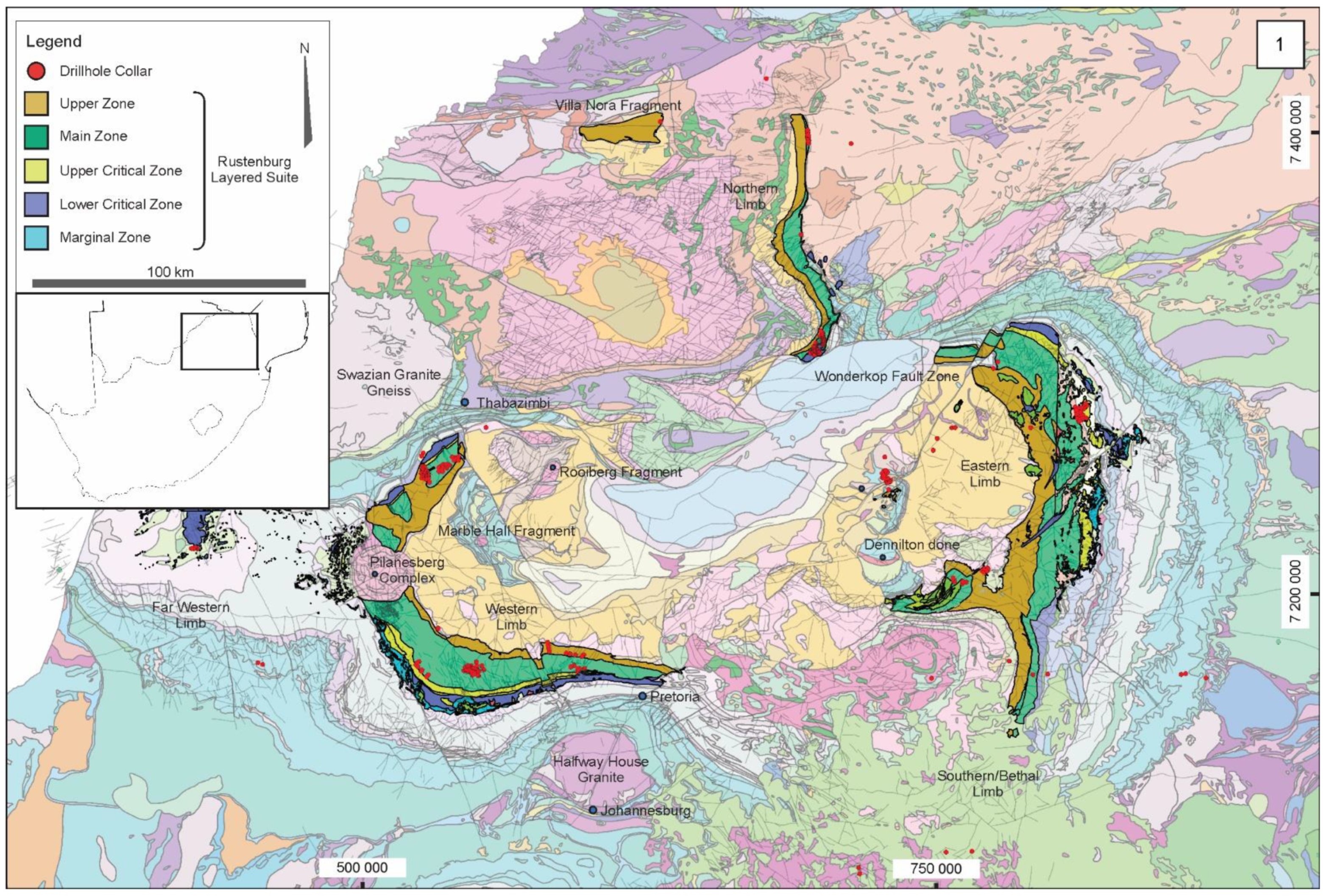
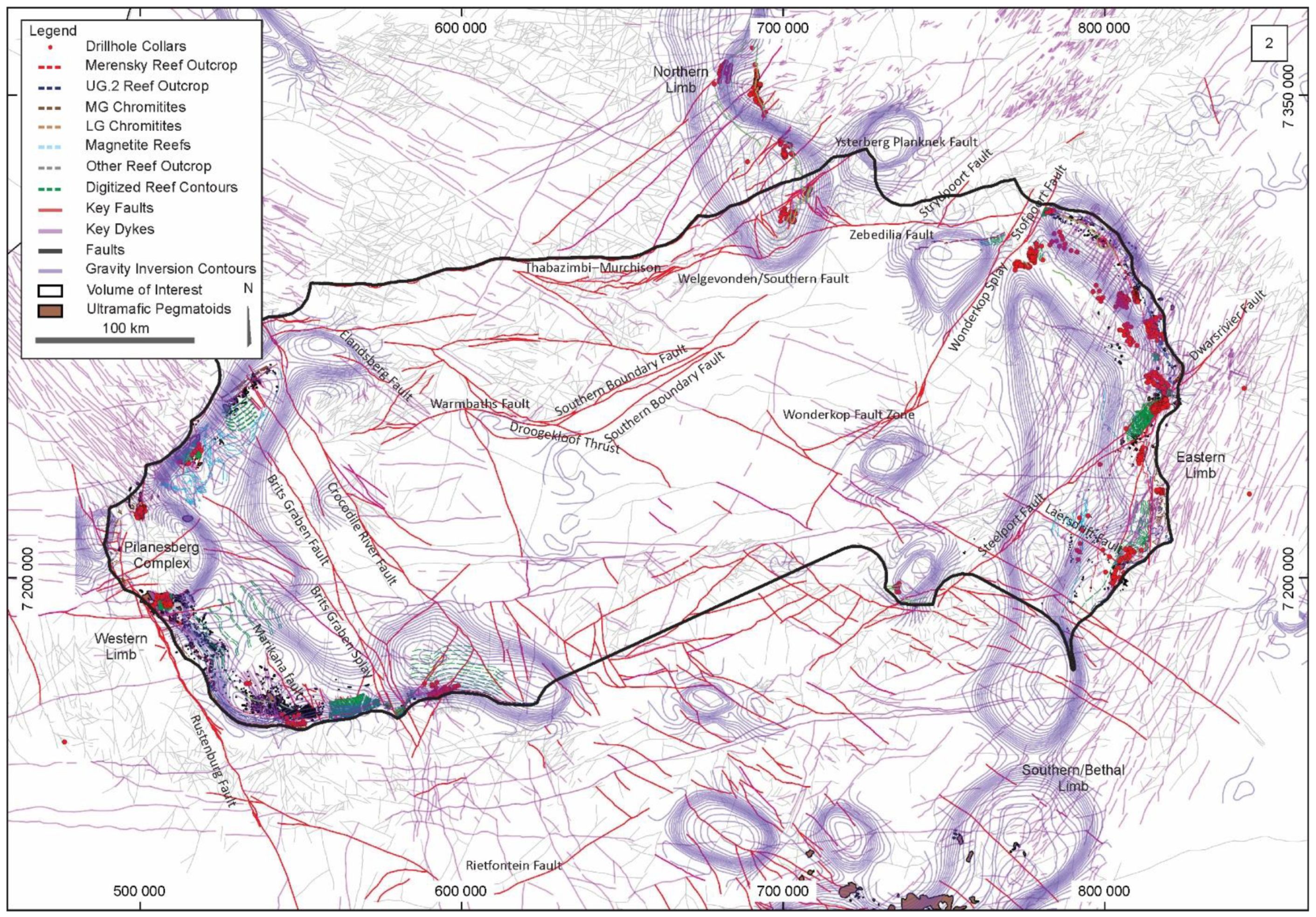
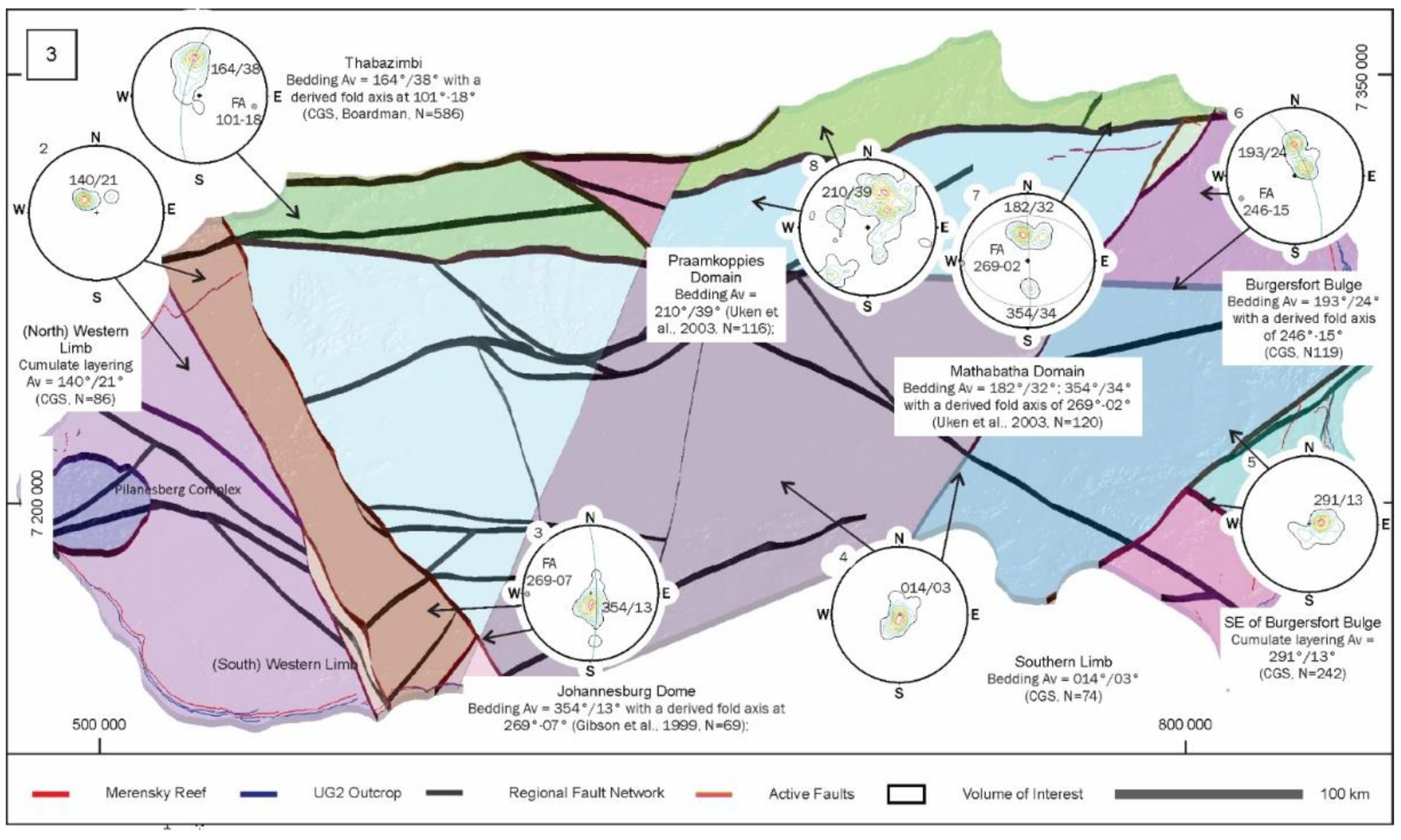
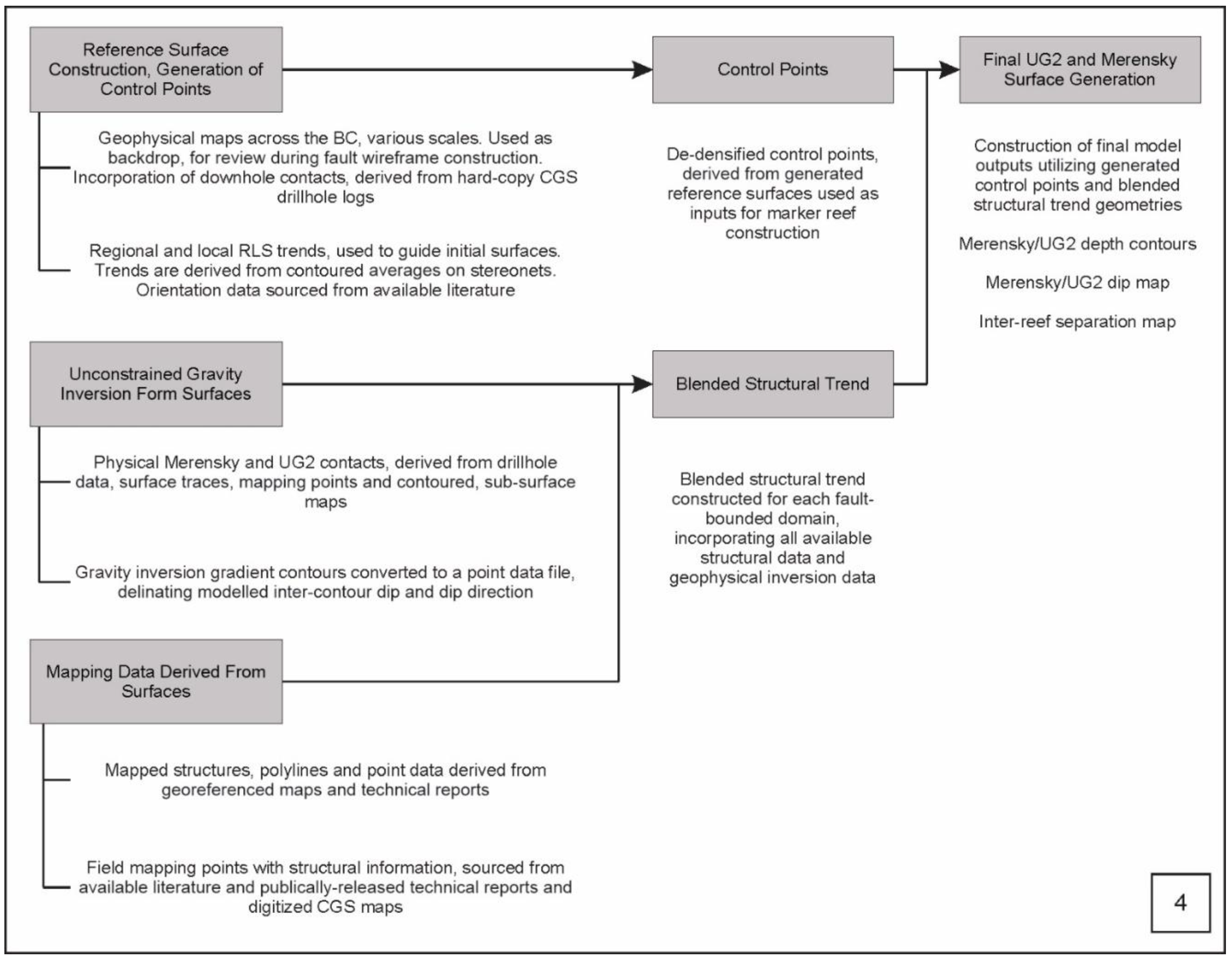
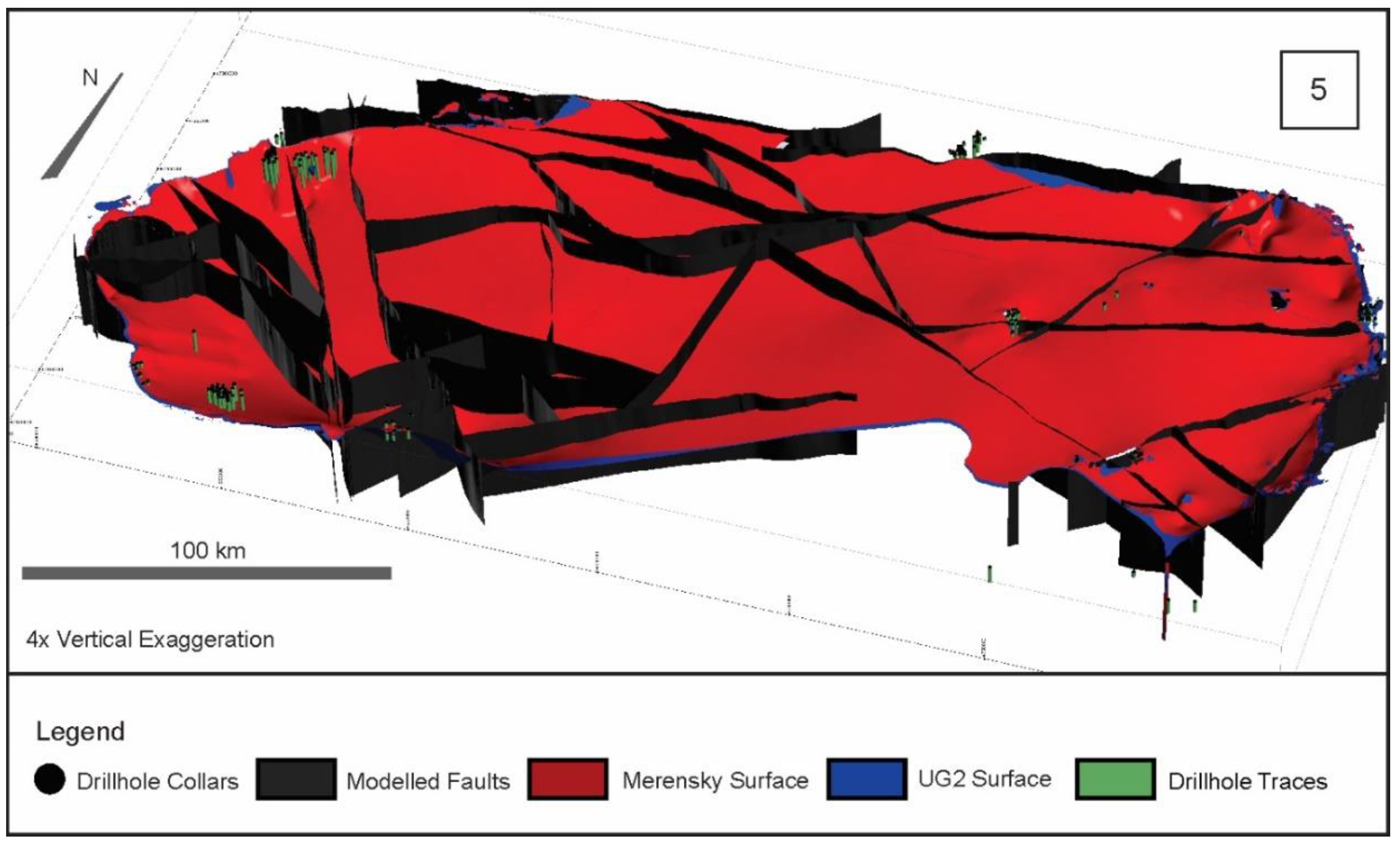
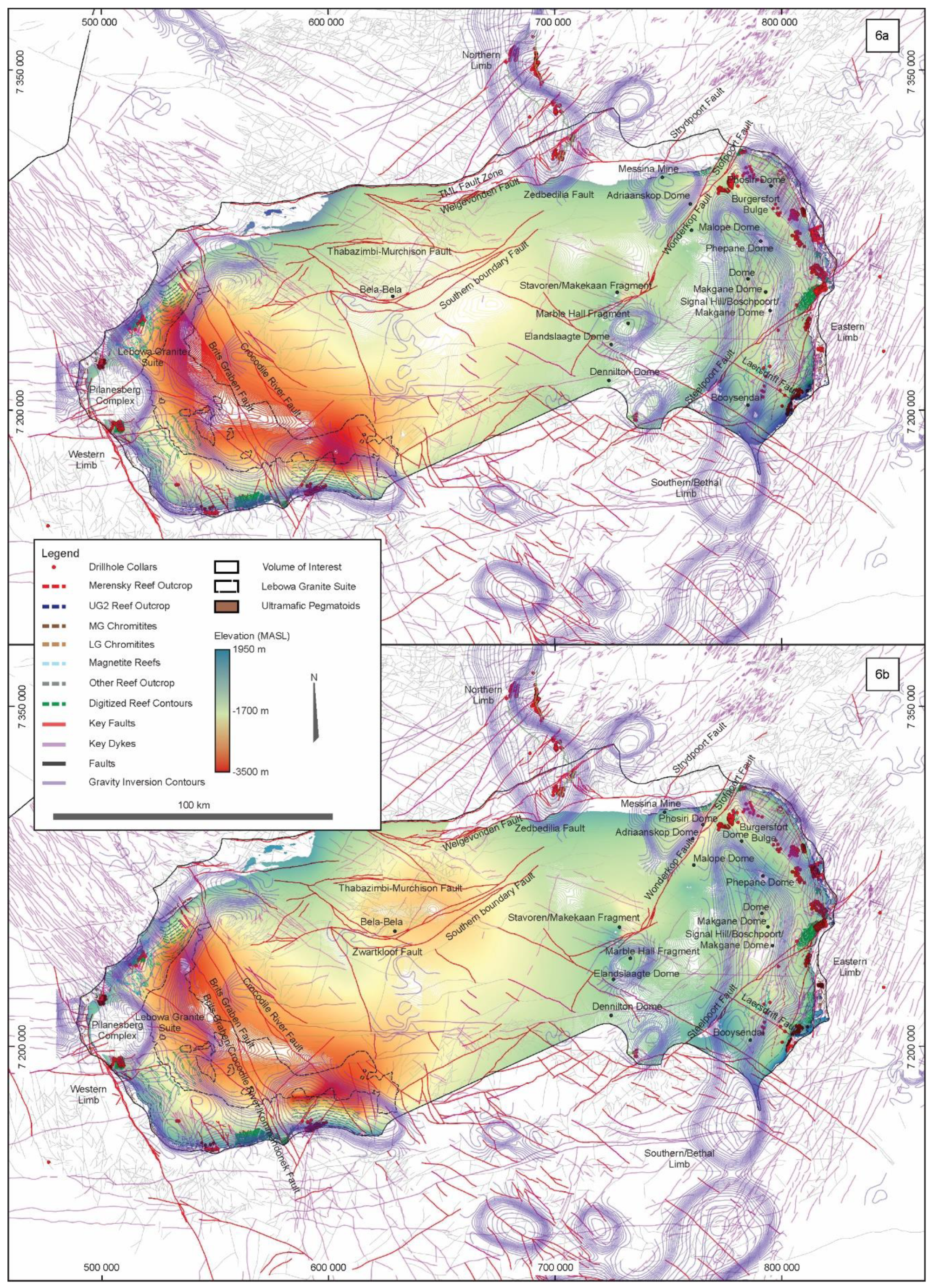
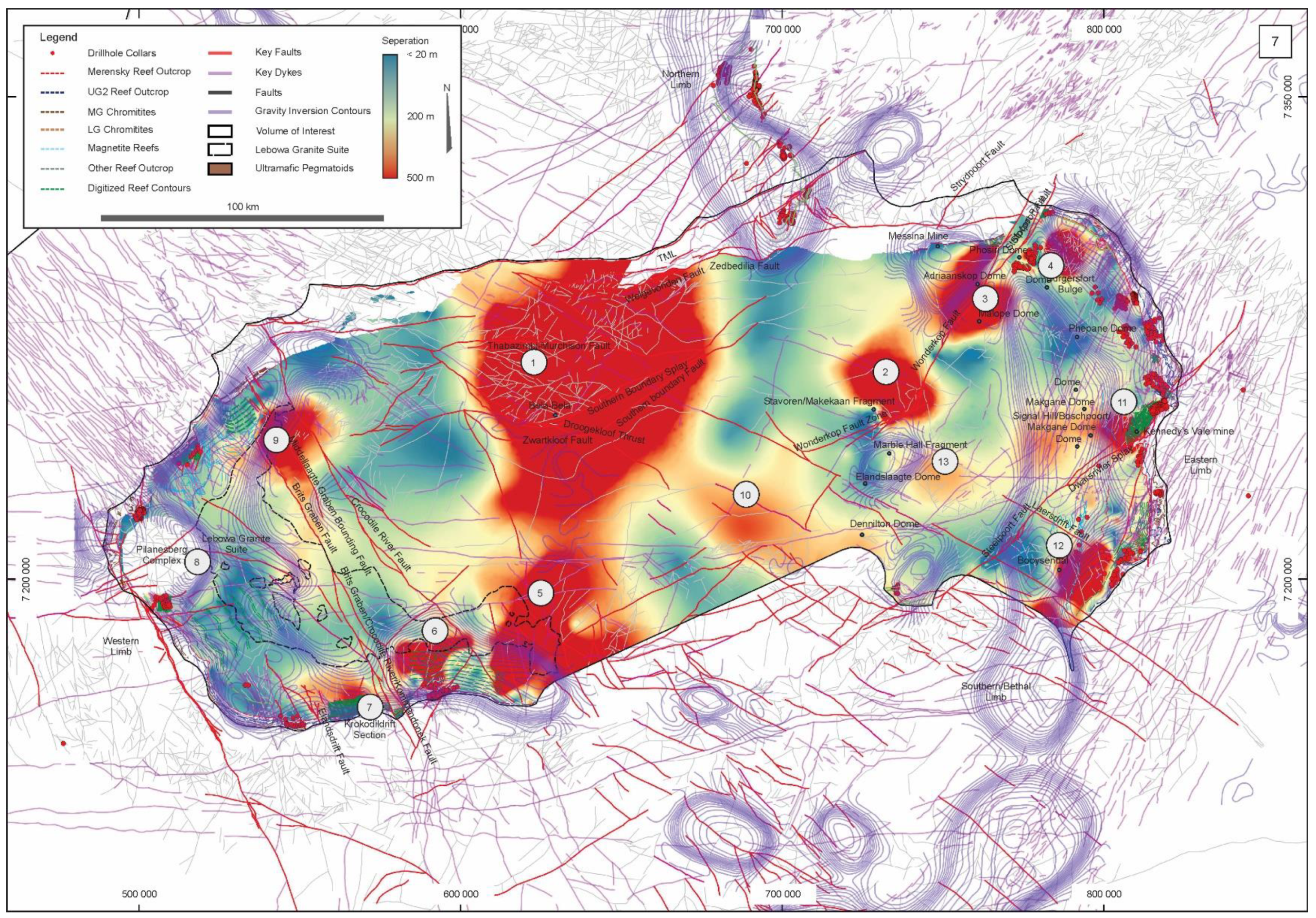
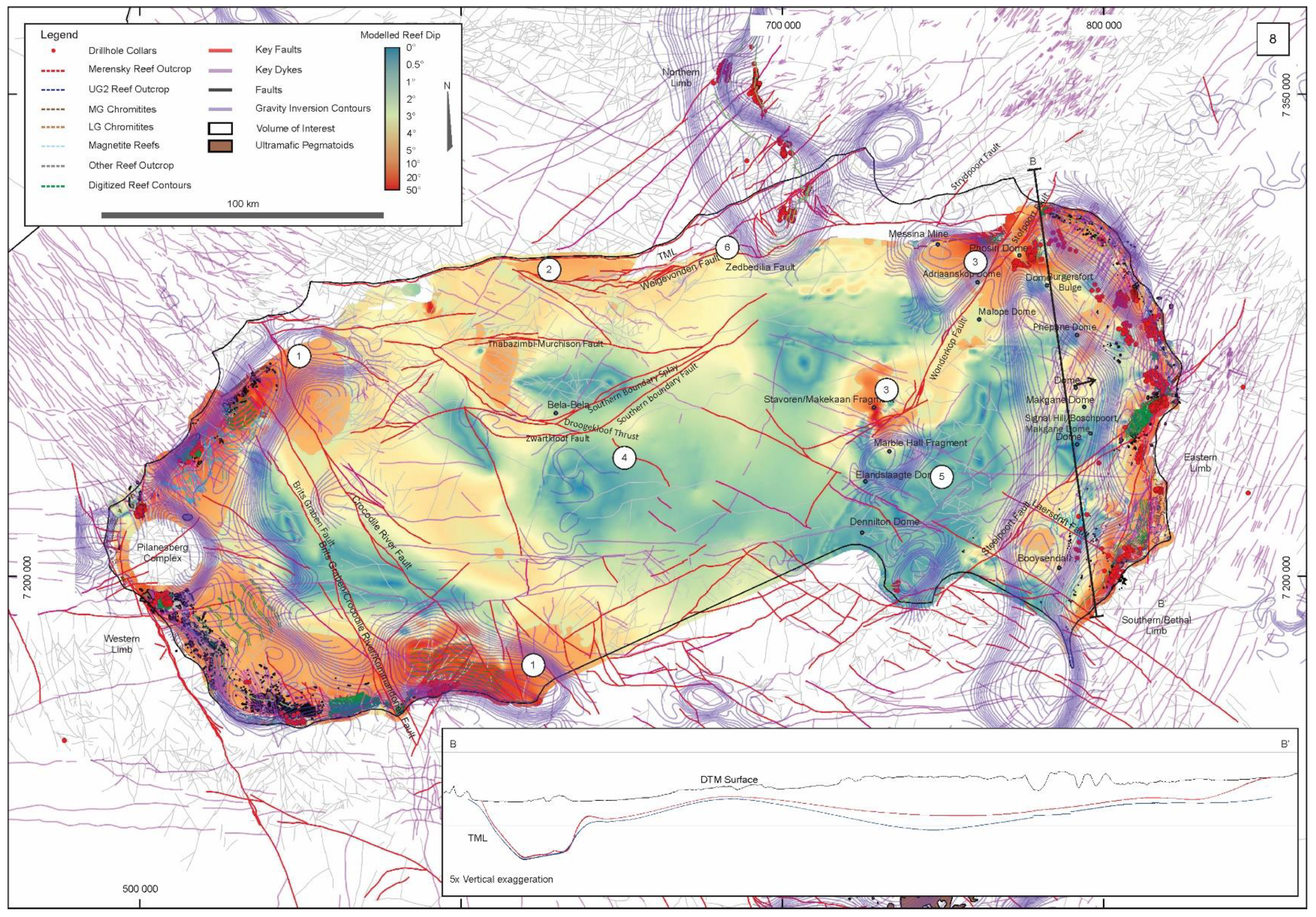
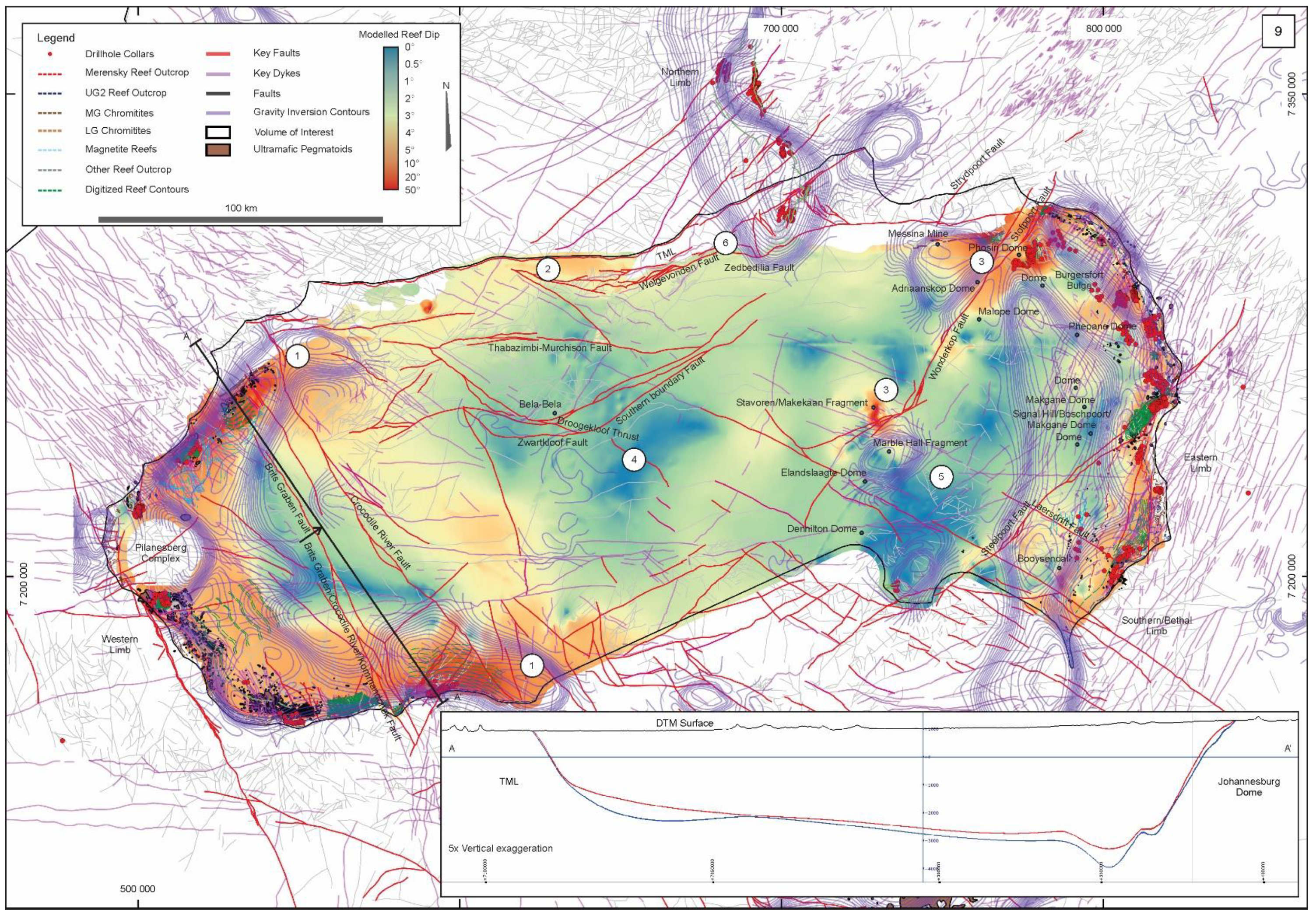
Publisher’s Note: MDPI stays neutral with regard to jurisdictional claims in published maps and institutional affiliations. |
© 2020 by the authors. Licensee MDPI, Basel, Switzerland. This article is an open access article distributed under the terms and conditions of the Creative Commons Attribution (CC BY) license (http://creativecommons.org/licenses/by/4.0/).
Share and Cite
Stoch, B.; Basson, I.J.; Miller, J.A. Implicit Geomodelling of the Merensky and UG2 Reefs of the Bushveld Complex from Open-Source Data: Implications for the Complex’s Structural History. Minerals 2020, 10, 975. https://doi.org/10.3390/min10110975
Stoch B, Basson IJ, Miller JA. Implicit Geomodelling of the Merensky and UG2 Reefs of the Bushveld Complex from Open-Source Data: Implications for the Complex’s Structural History. Minerals. 2020; 10(11):975. https://doi.org/10.3390/min10110975
Chicago/Turabian StyleStoch, Ben, Ian James Basson, and Jodie A. Miller. 2020. "Implicit Geomodelling of the Merensky and UG2 Reefs of the Bushveld Complex from Open-Source Data: Implications for the Complex’s Structural History" Minerals 10, no. 11: 975. https://doi.org/10.3390/min10110975
APA StyleStoch, B., Basson, I. J., & Miller, J. A. (2020). Implicit Geomodelling of the Merensky and UG2 Reefs of the Bushveld Complex from Open-Source Data: Implications for the Complex’s Structural History. Minerals, 10(11), 975. https://doi.org/10.3390/min10110975




